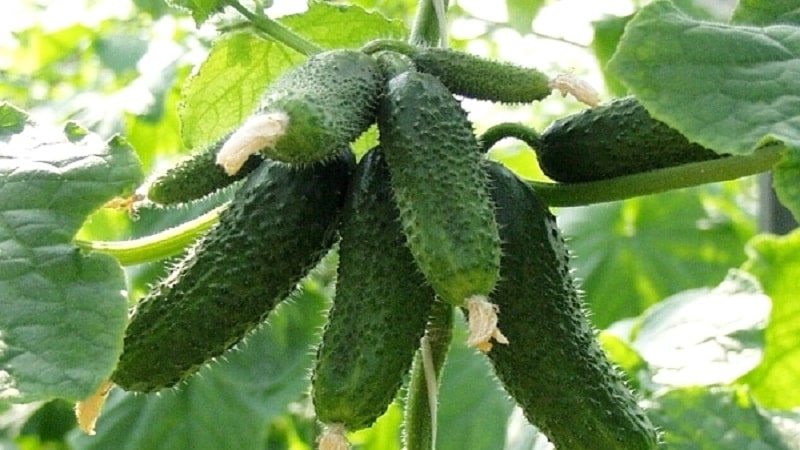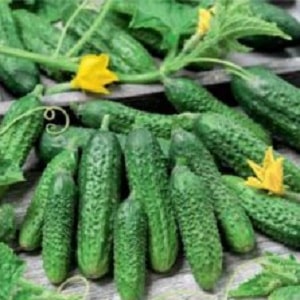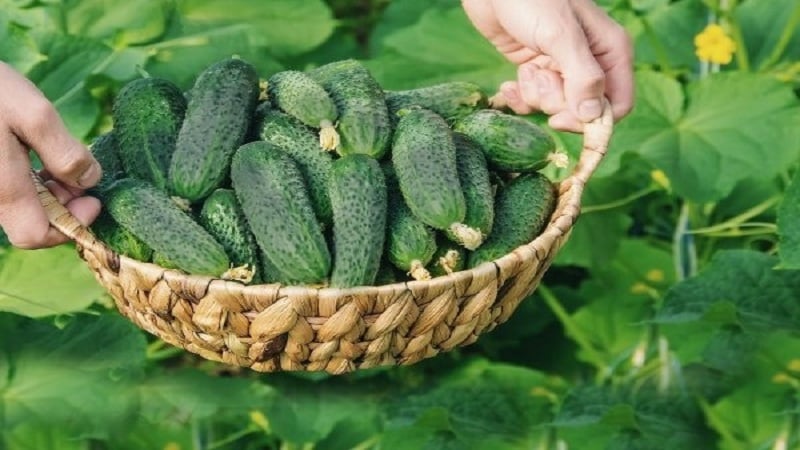Why do many summer residents love the “Amur” cucumber hybrid so much: a review of characteristics, advantages and disadvantages
Cucumber Amur f1 is distinguished by early ripening, uniform yield in the first month and extended fruiting in the future. The fruits have a smooth, spindle-shaped shape, crispy flesh without bitterness and a dense peel with a large number of sharp thorns.
Strong immunity to major crop diseases and the ability to regulate branching greatly simplify agricultural practices. When growing, it is important to regularly feed the bushes, water the plants on time and maintain optimal air temperature.
Description of the hybrid
The ultra-early ripening hybrid Amur was bred specifically for cultivation in spring-summer rotation under film covers. The crop is also grown in open ground in regions with warm and long summers. Originator - LLC selection and seed production company "Manul". The hybrid was included in the State Register of Breeding Achievements of Russia in 2000.
Distinctive features
The bushes are indeterminate, vigorous, weakly climbing, with female flowers. The culture has the ability to independently regulate branching. The rhizome is powerful.
In the photo - Amur f1 cucumbers.

The characteristics and main indicators of the hybrid are presented in the table.
| Indicators | Characteristic |
| Ripening period | 37-40 days |
| Pollination type | Parthenocarpic |
| Weight | 90-110 g |
| Length | 12-15 g |
| Form | Fusiform, shortened |
| Coloring | Green with light stripes |
| Leaves | Medium size, green in color, slightly wrinkled, with slightly wavy edges |
| Pulp | Dense, crispy |
| Taste | Sweetish, without bitterness |
| Skin | Dense, finely tuberculate with a short neck and white pubescence |
| Purpose | Universal |
| Productivity | 12-14 kg/m² |
| Sustainability | To cucumber mosaic virus, cladosporiosis, powdery mildew |
| Transportability | High |
Chemical composition, calorie content and beneficial properties
Nutritional value of cucumbers (per 100 g):
- calorie content - 14 kcal;
- proteins - 0.8 g;
- fats - 0.1 g;
- carbohydrates - 2.5 g;
- water - 95 g;
- fiber - 1 g.
Table of vitamin and mineral composition
| Name | Content | Norm |
| Vitamin A | 10 mcg | 900 mcg |
| Beta carotene | 0.06 mg | 5 mg |
| Vitamin B1 | 0.03 mg | 1.5 mg |
| Vitamin B2 | 0.04 mg | 1.8 mg |
| Vitamin B4 | 6 mg | 500 mg |
| Vitamin B5 | 0.27 mg | 5 mg |
| Vitamin B6 | 0.04 mg | 2 mg |
| Vitamin B9 | 4 mcg | 400 mcg |
| Vitamin C | 10 mg | 90 mg |
| Vitamin E | 0.1 mg | 15 mg |
| Vitamin H | 0.9 mcg | 50 mcg |
| Vitamin K | 16.4 mcg | 120 mcg |
| Vitamin PP | 0.3 mg | 20 mg |
| Potassium | 141 mg | 2500 mg |
| Calcium | 23 mg | 1000 mg |
| Silicon | 53 mg | 30 mg |
| Magnesium | 14 mg | 400 mg |
| Sodium | 8 mg | 1300 mg |
| Sulfur | 6.5 mg | 1000 mg |
| Phosphorus | 42 mg | 800 mg |
| Chlorine | 25 mg | 2300 mg |
| Iron | 0.6 mg | 18 mg |
| Iodine | 3 mcg | 150 mcg |
| Cobalt | 1 mcg | 10 mcg |
| Manganese | 0.18 mg | 2 mg |
| Copper | 100 mcg | 1000 mcg |
| Molybdenum | 1 mcg | 70 mcg |
| Selenium | 0.3 mcg | 55 mcg |
| Fluorine | 17 mcg | 4000 mcg |
| Chromium | 6 mcg | 50 mcg |
| Zinc | 0.215 mg | 12 mg |
Benefits of cucumbers for the body:
- restore water balance;
- speed up metabolism;
- cleanse blood vessels;
- normalize blood pressure;
- reduce the level of “bad” cholesterol;
- the juice whitens the skin and moisturizes;
- correct the functioning of the pancreas.
Agricultural technology for cucumbers
The crop is grown by seedlings and by direct sowing into the ground.Caring for plantings involves frequent loosening, weeding, watering and fertilizing with organic and mineral fertilizers. The hybrid is resistant to major crop diseases.
Planting by seed
Cucumbers are cultivated on fertile, loamy and breathable soils. The main rule for successfully growing crops is crop rotation and saturation of the soil with useful substances. In open areas it is easier to comply with these conditions, but in a greenhouse it is much more difficult. More often, crops are simply swapped from year to year. This leads to rapid soil depletion and the accumulation of pathogenic microorganisms. Gardeners are forced to either replace the top layer of soil with a new one or sow green manure. The second method is less labor-intensive.
White mustard restores soil fertility in a greenhouse, radish oilseed, beans, peas, soybeans. Oats increases the level of nitrogen, potassium and phosphorus, inhibits the development of fungi and bacteria.
Green manure is sown in the fall, and after 30-35 days it is mowed and embedded in the ground. To accelerate decay, water with microbiological preparations “Vostok-EM” or “Baikal-EM”.
Reference. In open ground, green manure is sown in early spring. Lupine, oats, clover, and legumes are used. Rotten plants improve the soil structure and act as mulch.
Hybrid Amur f1 is suitable for growing without seedlings due to its early ripening period. When carrying out sowing work, experts recommend:
- Pre-etch the seeds in a 1% solution of potassium permanganate (1 g/100 ml of water) and soak in growth stimulants “Epin” or “Zircon”.
- The timing of sowing is determined depending on the climatic zone: in the southern regions - in early May, in the middle regions - in the third ten days of May or early June.
- First loosen the soil and fertilize it with chicken droppings (10 liters per 1 m²).
- Form the beds with a bayonet shovel and level with a rake. The width of the beds is 70 cm, the depth is 20 cm. Form a 1-2 cm furrow in the middle and fill it with a hot concentrated solution of potassium permanganate.
- Plant the seeds to a depth of 1-2 cm and sprinkle with damp peat.
- Cover the beds with agrofibre to protect against night frosts, maintain moisture and ensure friendly shoots.
- After the sprouts appear, remove the film and thin out by pinching weak seedlings.
Planting by seedlings
Sowing seeds for seedlings is carried out 3-4 weeks before the planting date, following standard technology:
- Prepare a soil mixture of two parts peat and humus, one part sawdust or river sand. Disinfect in the oven at a temperature of +110 °C or fill with Fitosporin M solution.
- Pre-etch the seeds in potassium permanganate and germinate on damp cotton cloth. For sowing, use the hatched grains.
- Fill 0.5 liter peat cups with moist soil and plant two grains to a depth of 1-2 cm. Stretch the film on top and place in a warm place.
- After the sprouts appear, remove the film and place the containers on the windowsill on the south side.
- Inspect the seedlings and leave only strong shoots, trim weak ones with scissors at ground level.
- Water generously with warm, clean water once a week.
- Plant the seedlings in a permanent place at the stage of 4 true leaves, after warming the soil to at least +17 °C, and the air to +22 °C.
- Planting pattern: 20x70 cm, 4-5 bushes per 1 m².
- Hill up the roots, lightly compact the soil and water generously with warm water.
Growing and care
Rules for caring for crops:
- Maintain the air temperature in the greenhouse at +22…+25 °C
- Water bushes at the root with warm rain or settled water 3-4 times a week or install a drip irrigation system.
- Regularly loosen and weed the beds. Remove weeds with their rhizomes.
- Form the plant according to the rules adopted for parthenocarpics and tie it to a trellis.
- Feed cucumbers with organic and mineral fertilizers at least 5 times per season.
In the table there is a diagram fertilizing cucumbers
| Stage of development | Fertilizer |
| Before flowering | 200 ml of pasty chicken or quail droppings per 5 liters of water. Water the bushes at the root once after planting. |
| During the flowering period (10 days after the first feeding) | 1 tbsp. l. ready-made fertilizers to choose from (“Ideal”, “Breadwinner”, “Fertility”) per 10 liters of water. The consumption rate per 1 m² is 5 l. Use for foliar feeding. |
| 10 g ammonium nitrate, 20 g superphosphate, 10 g potassium sulfate per 10 liters of water. The solution is enough to water 1 m². | |
| During the fruiting period (10 days after the second feeding) | 0.5 liters of mullein per 10 liters of water. Water the bushes at the root. |
| 20 g of potassium sulfate per 10 liters of water. Consumption - 5 l per 1 m². | |
| 100 g of wood ash per 10 l. Use for root watering. |
Advice. Alternate root and foliar feeding. Apply the former in sunny and dry weather, the latter in cloudy weather.
Features of cultivation and possible difficulties
A parthenocarpic hybrid is formed according to the standard scheme, despite the ability of the culture to independently regulate branching:
- In the first 5-6 leaf axils, all ovaries and shoots are removed.
- The main stem is led to the trellis, removing the stepsons and leaving only the ovaries.
- As soon as the stem reaches the crossbar, it is wrapped around it several times and the crown is pinched, or thrown over the bar and the growth point is stopped a meter from the ground.
- In the early morning, remove the lower yellow and dry leaves.
Diseases and pests
Hybrid Amur is resistant to cucumber mosaic, cladosporiosis, powdery mildew, but tolerant to downy mildew (peronosporosis).
Signs of the disease:
- yellow and brown spots on leaves;
- purple-gray plaque on the back side;
- yellowing of green mass and wilting of bushes.
The fight against fungus is complicated by the early ripeness of the hybrid. The first fruits appear a month after the entrances appear, so fungicide treatment is not carried out.
The best way to preserve the harvest is to prevent the development of fungus and infection of plants:
- in the spring, disinfect the soil with copper sulfate (50 g per 10 liters of water) or “Fitosporin”;
- regularly remove weeds;
- immediately remove the affected bushes with rhizomes and burn them;
- observe crop rotation;
- plant green manure;
- treat the bushes with whey (kefir) with iodine (10 drops per 1 liter);
- feed with vitamin preparations: “Energen Extra”, “Novosil”.
Reference. Preventive treatments are carried out from the beginning of flowering to the end of the season.
Cucumber plantings are most often attacked by melon aphids, whiteflies, spider mites, and slugs. Folk remedies are used to control pests.
| Pest | Signs | Treatment |
| Spider mite | Small white dots on the back of leaves, thin cobwebs on bushes | Fill the bucket ½ full with tomato tops and fill it with water to the brim.Boil over low heat for half an hour and add 25 g of liquid soap. Add water 1:2, use to treat plantings 1 time/7 days |
| Aphid | Drooping leaves, drops of honeydew, a large concentration of ants | 100 g of onion peel per 1 liter of water. Leave for 4-5 days, add 50 g of laundry soap shavings and add water 1:2 |
| Whitefly | Sticky coating on stems and leaves, many white larvae at an early stage and flocks of white moths at a late stage | Fill a 200 liter barrel ½ full with bird cherry greens and pour boiling water over it. After 24 hours, use for spraying bushes and watering the soil.
|
| Slugs | Shiny mucus on leaves, holes in cucumbers | Install beer can traps in the area, treat the bushes with ammonia solution (4 tablespoons per 10 liters of water), and carry out manual collection at night |
Harvesting and application

The first cucumbers appear approximately 35 days after full germination. The fruiting of the crop is extended; it produces the bulk of the harvest in the first month of fruiting.
Harvesting is carried out every 3-4 days. The fruits do not overgrow, do not barrel, and no voids form inside. Cucumbers are suitable for fresh consumption and conservation.
The fruits do not turn yellow during long-term storage and tolerate long-distance transportation well. Store for 2-3 weeks in a cool place.
Advantages and disadvantages
Advantages:
- high productivity;
- early ripeness;
- fruit evenness;
- ease of care;
- long fruiting;
- high level of transportability;
- keeping quality;
- excellent taste without bitterness;
- amicable maturation;
- resistance to major diseases.
Flaws:
- rough skin;
- the need to mold plants and tie them to the trellis.
Reviews
Hybrid Amur is highly valued for its ease of care, high yield and excellent taste.
Vladimir, Podolsk: «I grow Amur cucumbers indoors. The plant produces its harvest almost simultaneously, the main part in the first month. I form it into one stem and tie it to the trellis. The fruits are not bitter, but if you don’t pick them in time, the skin will be tough.”
Valentina, Ivangorod: “An excellent hybrid for greenhouse cultivation. This is not the first year I have been planting and I am always pleased with the result. The cucumbers are smooth, with a large number of small sharp pimples. The pulp is sweet, not bitter. We eat cucumbers in salads and seal them in jars for the winter.”
Conclusion
The ultra-early ripening hybrid Amur is cultivated mainly in closed ground. They are grown in open areas in the southern regions. The culture is undemanding to the composition of the soil, pleases with extended fruiting and strong immunity to the main “cucumber” diseases. Cucumbers do not outgrow, are stored for a long time in a cool room, do not turn yellow and do not lose their presentation.
A plant with a female type of flowering does not need pollination by bees, therefore it is suitable for growing in greenhouses and hotbeds. Medium-branched bushes are formed into one stem and tied to a trellis for better ventilation and support of high productivity.